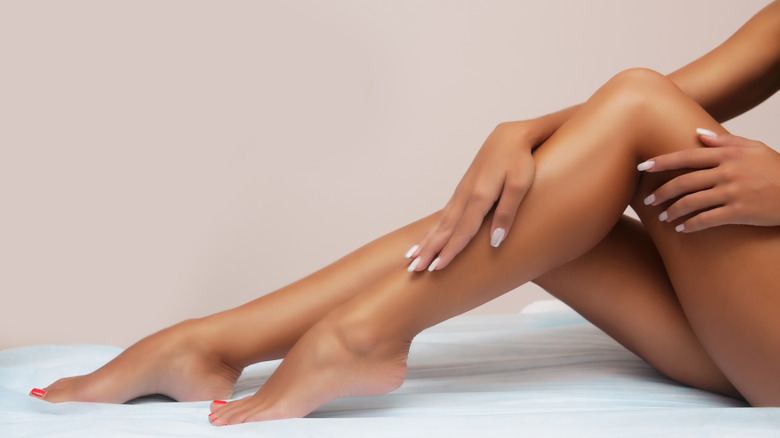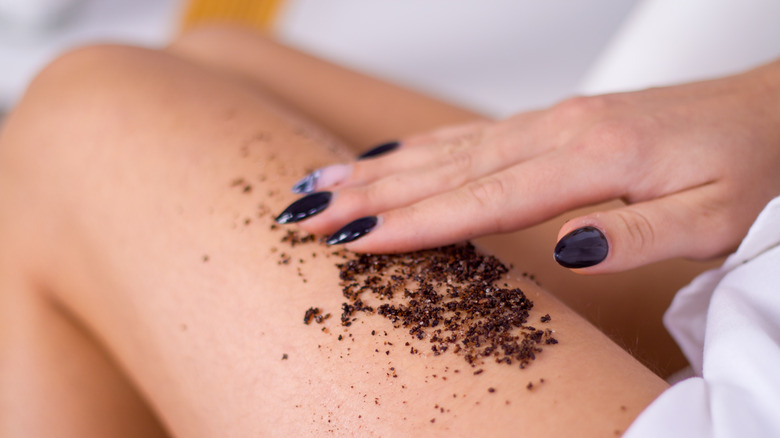When Should You Exfoliate In Your Shaving Routine?
When it comes to hair removal methods, many choose to shave because it seems like the easiest, cheapest, and quickest option. You simply wet, lather, shave, and moisturize, all from the comfort of your home. While shaving is generally quicker and easier than other forms of hair removal, rushing it and leaving out important steps, like exfoliating, can reduce the quality of your shave and even harm your skin.
The American Academy of Dermatology Association defines exfoliation as "the process of removing dead skin cells from the outer layer of your skin." The institution highlights that exfoliation should always be carried out safely and gently; otherwise, it could negatively impact the skin. But when done properly, exfoliating leads to many benefits, including skin that feels silky and smooth, clearer pores, and improved blood circulation that can reduce the appearance of scars (via Zwivel). Experts agree that exfoliation is a vital part of the shaving process, and when you exfoliate makes all the difference; exfoliating incorrectly or at the wrong time during your shaving routine can cause irritation. So, is it better to exfoliate before or after you shave?
When should you exfoliate?
Skin experts across the board generally agree that you should exfoliate before you shave (via MindBodyGreen). This is because the process of exfoliating can actually lift hairs that are lying flat or trapped under the skin, so there's less chance of the razor causing irritation. You're also less likely to get pesky ingrown hairs if you exfoliate before shaving, as ingrown hairs occur when skin covers newly growing hair. By removing the top layer of dead skin with exfoliation, you allow the hairs to grow back without any obstruction. Exfoliating prior to shaving is also easier on your razor, as you won't clog up the spaces between the blades with dead skin.
According to Gillette, exfoliating directly after you shave can be harmful to your skin. The goal after shaving is to close the pores, not open them. Additionally, exfoliating freshly shaved skin can irritate any cuts or burns that you might have made while shaving. However, it is beneficial to exfoliate a few days after shaving (via Dove). This will clear away more dead skin cells and reduce the chance of the new hairs becoming ingrown.
How to exfoliate
Exfoliating properly is important, as rushed or overly rough exfoliation can damage the skin. The first step is choosing your exfoliator, as there are a few variations on the market. Primarily, there are two categories of exfoliators. The first is physical exfoliators, including scrubs, gloves, and brushes (via Healthline). The second category is chemical exfoliators, which contain either alpha-hydroxy acids (AHAs) or beta-hydroxy acids (BHAs). Generally, drier or sensitive skin types benefit from chemical exfoliators while oilier skin is more suited to physical exfoliators. Some experts argue that physical exfoliation is better than chemical exfoliation before shaving because it is more aggressive in removing dead skin cells (via RestOviebelle).
To properly exfoliate before shaving, wet your skin with warm water, preferably in the shower (via the India Times). Take your exfoliating product and gently rub it in a circular motion over the area where you're going to shave. It's important not to be too harsh with this step to avoid irritating the skin. Rinse off any residue. Then apply shaving cream or gel and begin shaving, ideally with a high-quality sharp razor blade. Taking your time can reduce the chance of nicks and cuts. If you can handle it, rinse your skin off with cold water to close the pores, and then rub in a moisturizer. The result should be silky smooth skin that feels amazing to touch!


